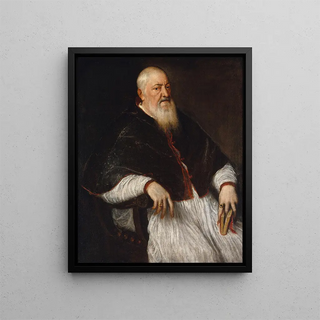Art print | Filippo Archinto born around 1500 died in 1558 Archbishop of Milan - Titian


View from behind

Frame (optional)
The work of Titian, "Filippo Archinto born around 1500 died in 1558 archbishop of Milan," stands as a compelling testament to the Italian Renaissance, a period where art and spirituality intertwine with rare intensity. This portrait, capturing the very essence of its subject, transcends the simple frame of painting to become an open window into a bygone era. Through the penetrating gaze of the archbishop, the viewer is invited to delve into the intricacies of the human soul and the political issues of his time. Titian's mastery in the use of colors and textures brings this historical figure to life, making this piece a must-have for any art enthusiast.
Style and uniqueness of the work
The uniqueness of this portrait lies in how Titian manages to blend realism and idealization. Filippo Archinto's features are rendered with striking precision, while the blurred background emphasizes the presence of the subject, placing him at the center of attention. The choice of palette, oscillating between warm tones and delicate shadows, confers emotional depth to the work that cannot leave viewers indifferent. The sumptuous drapery of the archbishop's robe, richly decorated, not only testifies to his high status but also showcases Titian's technical virtuosity. He does not merely depict a man: he portrays a spirit, an intellect, a man of faith deep in thought, thus capturing the very essence of human dignity.
The artist and his influence
Titian, whose real name is Tiziano Vecellio, is one of the giants of Venetian painting and a pillar of the Renaissance. His career, spanning nearly seven decades, is marked by an impressive stylistic evolution. From his beginnings influenced by the styles of Bellini and Giorgione to his peak, where he developed a bold and expressive technique, he established himself as an undisputed master. His influence extends well

Matte finish

View from behind

Frame (optional)
The work of Titian, "Filippo Archinto born around 1500 died in 1558 archbishop of Milan," stands as a compelling testament to the Italian Renaissance, a period where art and spirituality intertwine with rare intensity. This portrait, capturing the very essence of its subject, transcends the simple frame of painting to become an open window into a bygone era. Through the penetrating gaze of the archbishop, the viewer is invited to delve into the intricacies of the human soul and the political issues of his time. Titian's mastery in the use of colors and textures brings this historical figure to life, making this piece a must-have for any art enthusiast.
Style and uniqueness of the work
The uniqueness of this portrait lies in how Titian manages to blend realism and idealization. Filippo Archinto's features are rendered with striking precision, while the blurred background emphasizes the presence of the subject, placing him at the center of attention. The choice of palette, oscillating between warm tones and delicate shadows, confers emotional depth to the work that cannot leave viewers indifferent. The sumptuous drapery of the archbishop's robe, richly decorated, not only testifies to his high status but also showcases Titian's technical virtuosity. He does not merely depict a man: he portrays a spirit, an intellect, a man of faith deep in thought, thus capturing the very essence of human dignity.
The artist and his influence
Titian, whose real name is Tiziano Vecellio, is one of the giants of Venetian painting and a pillar of the Renaissance. His career, spanning nearly seven decades, is marked by an impressive stylistic evolution. From his beginnings influenced by the styles of Bellini and Giorgione to his peak, where he developed a bold and expressive technique, he established himself as an undisputed master. His influence extends well






